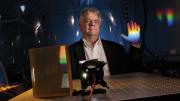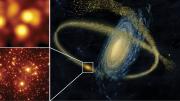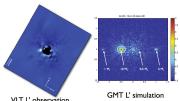Is there life beyond Earth? Likely no question excites greater lay interest in space science. Answering it requires astronomers to find planets (not simple, because stars are big and bright, their satellites small and dim) and then characterize them (in the habitable zone—neither too hot nor too cold for liquid water—with a sheltering atmosphere, and probably a rocky composition rather than a gaseous one like Jupiter’s).
In fact, during the past 10 years—following discovery of the first exoplanet, orbiting 51 Pegasi, in 1995—“We’ve learned how to detect large gas planets” quite competently, says professor of astronomy David Charbonneau. During the next decade, he says, astronomers should move ahead on “detecting and characterizing analogs of Earth.” If that occurs, Harvard astronomers, and their Smithsonian observatory colleagues at the Center for Astrophysics (CfA), in Cambridge, will play a large role. “We have the strongest observational exoplanet group,” says Baird professor of science Avi Loeb, chair of astronomy. In fact, he says, “It’s quite likely we’ll find an Earth analog in the next year.”
The astronomical advances made to date, and those to come, depend on acutely sensitive instruments. Given the difficulty of seeing a planet apart from its nearby star’s light, exoplanets have been discovered indirectly. Although a star like the Sun comprises almost all the mass of any planetary group, the smaller, orbiting bodies do exert some pull on the star and therefore on the system’s gravitational center. Minute differences in the star’s apparent speed toward or away from an observer can be read when its light is spread into a spectrum and interpreted using a spectrograph. (A source of light—a distant galaxy, say—that is moving away appears to spread its light toward the red, longer wavelengths, and so is “red-shifted”; when moving toward the observing instrument, its light is slightly compressed toward the shorter, blue wavelengths, and so is “blue-shifted.” Think of the change in the pitch of a siren as it recedes or approaches.) These readings of “radial velocity” confirmed the first remote-planet discovery. An Earth-mass planet in the Alpha Centauri star system, reported last autumn, was found after four years and 450 observations; the planet imparted a velocity of some 20 inches (50 centimeters) per second to its star—a magnitude detectable at a distance of 4.4 light years (about 25 trillion miles).
The Kepler space observatory, launched in 2009, monitors about 145,000 nearby stars, looking for slight changes in their brightness as an orbiting planet transits in front of them, blocking a small fraction of their light. This transit method of observation has yielded nearly 3,000 planet candidates, and made scientists think that planets surrounding the Milky Way’s 100 billion stars must number in the billions—making for an enormous number of Earth-like candidates.
So attention turns to Charbonneau’s aim for the next 10 years of research—building on his initial detection of remote atmospheres and measurements of planets’ surface temperatures. Determining whether exoplanets “that might harbor the conditions for life” actually do is just beyond the capacity of current instruments, says professor of astronomy Charles Alcock, the CfA director.
Enter the Giant Magellan Telescope (GMT)—under development since exoplanet science began to accelerate—and the instruments being designed for it. A larger telescope with adaptive optics will enable direct observation of some stars and surrounding planets, says lecturer on astronomy Jeffrey McClintock, a senior astrophysicist with the Smithsonian observatory and a GMT board member. When married to a sufficiently sensitive spectrograph, the captured light could reveal the presence of oxygen or chlorophyll, he says. How sensitive? “You need all the collecting area you can get,” he says, because there might be only a few photons in each spectral line.
Andrew Szentgyorgyi, of the CfA, leads an international team that spent six years defining the design and performance parameters for the spectrograph, dubbed the G-CLEF (the GMT-Consortium Large Earth Finder). “The aperture of the GMT is absolutely critical” for the intended science, he says, so enough photons are captured quickly enough to combine transit and radial-velocity observations to determine target exoplanets’ size, mass, velocity, density, geophysics, and atmospheric “fingerprints.” G-CLEF, a “first-light” instrument scheduled for operation when the new telescope is commissioned, is expected to be under contract this spring and will be assembled in Cambridge (incorporating components from partners in California, Chicago, and Chile). It aims to record orbiting planets’ gravitational effect on their stars’ velocity of as little as 10 centimeters per second: the Sun’s reflex motion in response to Earth’s gravitational pull. That is the speed, Szentgyorgyi notes, of a Galápagos tortoise if it ever chose to sprint. To achieve that sensitivity, the spectrograph will operate in the thermal isolation of a vacuum vessel, and detect shifts in spectral lines as small as the diameter of a single silicon atom.
With such capabilities, says University of Arizona associate professor Philip Hinz (who works on the GMT’s adaptive optics, and studies exoplanets), “We’ll be able to tell how common or weird our own planetary system is.” Until then, Charbonneau, from his office across the continent, is figuring out how to assess the atmospheres of the large, gaseous planets turned up by telescopes currently in use. But, he says, he is “yearning to study the planets that are Earth-like.”












